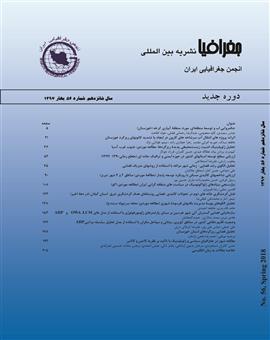حکمروایی آب و توسعه منطقه ای مورد: منطقه آبیاری کرخه(خوزستان)
محورهای موضوعی :عباس سعیدی 1 , عبدالرضا رحمانی فضلی 2 , جواد اطاعت 3 , کاوه معصومی 4
1 - دانشگاه شهید بهشتی
2 - دانشگاه شهید بهشتی
3 - دانشگاه شهید بهشتی
4 - دانشگاه شهید بهشتی
کلید واژه: توسعه پایدار توسعه منطقه ای حکمروایی خوب حکمروایی آب توسعه نامتوازن ایران,
چکیده مقاله :
چکیده آب و شیوههای کهن مدیریت و بهرهبرداری از آن در سرزمین ایران، که بخش وسیعی از قلمرو آن در اقلیم خشک و نیمهخشک قراردارد، همواره نقش بسیار مهمی در تحولات اجتماعی- اقتصادی و برپایی چشماندازهای فرهنگی برعهده داشته است. آغاز دورة نوگرایی در ایران و رویآوری به تدوین برنامههای میانمدت عمرانی (از 1327 به بعد)، همراه با اجرای اصلاحات ارضی (1341 بهبعد) و شاید از همه مهمتر، تغییر پایة درآمدی دولت از مالیات و دیون ارضی (بهرة مالکانه) به فروش نفت، در کنار رشد شتابان شهرگرایی و گسترش فعالیتهای صنعتی، زمینهساز تحولات بیسابقهای در عرصة حکمروایی آب در چارچوبی نوین، اما با محوریت دولت و در قالبی کاملا تمرکزگرا گردید. پس از پیروزی انقلاب اسلامی (1357)، روند گسترش بهرهبرداری از منابع آب در ابعادی بیسابقه مطرح شد که طی آن برنامههای پیشین عمران و توسعة منطقهای، با محوریت اب، در مناطق نوآباد و حائز مزیت نسبی، جای خود را به اجرای طرحهای توسعه در سرتاسر مناطق کشور داد. بدینسان، نگرش به مدیریت منابع آب و حکمروایی آن خصوصیات نسبتا تازهای یافت. این مقالة میکوشد- بصورت موردی- به بررسی حکمروایی آب و نقش آن در توسعة متوازن و پایدار و همچنین ارزیابی پیامدهای فضایی آن در منطقة آبیاری کرخه (خوزستان) بپردازد. این بررسی با تکیه بر روش ترکیبی (کمی- کیفی) و با استفاده از ابزار پرسشنامههای ساختارمند و مصاحبه، جلسات بحث متمرکز گروهی و مشاهده غیرمشارکتی و گفتگو بهانجام رسیده است. بر این اساس، کوشش شده است تا از نقطهنظرات همة بازیگران در سطوح مختلف ملی، منطقهای و محلی (شامل مدیران و کارشناسان حوزههای مختلف، از جمله استادان دانشگاه و خبرگان بخش آب و کشاورزی، محیط زیست، برنامهریزان توسعه، نمایندگان جوامع محلی و بهرهبرداران مستقیم از طرح، در قالب مصاحبههای فردی و گروهی بهرهگیری شود.
Water and its ancient exploitation methods in Iran, which a large part of its territory is characterized as arid and semi-arid, has continuously played a determinant role in establishment of cultural landscapes and as a whole, in its socio-economic developments. With the beginning of modernization and turning to new planning methods, with introducing interim development plans (from 1948 onwards), along with the implementation of Land Reform Act (1962), and perhaps most importantly, the change in the state's basic incomes from taxes and duties (shareholdings) to oil, with growth of urbanization and expansion of industrial activities, the country witnessed unprecedented changes in large scale water management, with focusing a completely centralized framework and dominant role of state. . After the Islamic Revolution (1979), the process of increasing the country's capacity to exploit the water resources was expanding unprecedentedly. During the period, regional development programs, with emphasis on water resources, in new land areas, with comparative advantage, gave way to implementation of development plans throughout the country. Thus, the attitude toward water resource management and its governance has received somewhat new features. This article tries to study these processes and approaches to water governance and their role in balanced and sustainable development, and, as well as, their spatial implications as a case, in the Karkheh irrigation zone(Khuzestan). The study was conducted on the basis of a mixed (quantitative and qualitative) method, using structured questionnaires and interviews, group focused discussion sessions and non-cooperative observation and discussion. Efforts have been made to review the Karkheh Irrigation Development Plan, based on the points of views of all stakeholders at various national, regional and local levels (including managers and experts from different fields, such as university professors, experts in water, agriculture, environment, development planning, local community representatives and common beneficiaries of the project), by using the methods of individual and group interviews.
